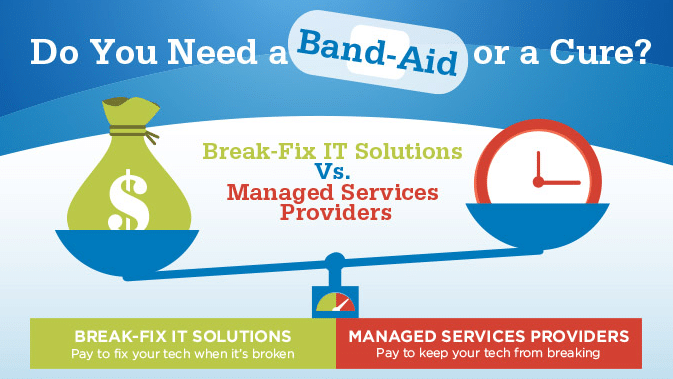Managed IT Services Vs. Break-Fix: Which Is The Better, More Cost-Effective Option?
The managed IT approach is, by far, the most cost-effective, smartest option for any small/medium-size business. The only time we would recommend a break-fix approach is when you already have a competent IT person or team proactively managing your computer network and simply have a specific IT project to complete that your current in-house IT team doesn’t have the time or expertise to implement (such as a network upgrade, installing a backup solution, etc.). Outside of that specific scenario, we do not think the break-fix approach is a good idea for general IT support for one very important, fundamental reason: you’ll ultimately end up paying for a pound of “cure” for problems that could have easily been avoided with an “ounce” of prevention.
Why Regular Monitoring And Maintenance Is Critical For Today’s Computer Networks
The fact of the matter is, computer networks absolutely, positively need ongoing maintenance and monitoring to stay secure. The ever-increasing dependency we have on IT systems and the data they hold
- not to mention the type of data we’re now saving digitally — has given rise to very smart and sophisticated cybercrime organizations who work around the clock to do one thing: compromise your networks for illegal activities.
In most cases their intent is to access financial information and passwords to rob you (or your clients), create fake identities for credit card fraud, etc. In other cases they may want to use your computer network to send illegal spam, host pirated software, spread viruses, etc. And some do it just for the “fun” of being able to make computer systems inoperable. These criminals work around the clock in teams, constantly finding and inventing new ways to get around your antivirus software and firewalls; that’s why you have to remain ever vigilant against their attacks.
Of course, this doesn’t even take into consideration other common “disasters” such as rogue employees, lost devices, hardware failures (which are the #1 reason for data loss), fire and natural disasters and a host of other issues that can interrupt or outright destroy your IT infrastructure and the data it holds. Then there’s regulatory compliance for any business hosting or touching credit card or financial information, medical records and even client contact information such as e-mail addresses.
Preventing these problems and keeping your systems up and running (which is what managed IT services is all about) is a LOT less expensive and damaging to your organization than waiting until one of these things happens and then paying for emergency IT services to restore your systems to working order (break-fix).
Should You Just Hire Full-Time IT Staff?
In most cases, it is not cost-effective for small and mid-size businesses to hire a full-time IT person, because you can outsource this function of your business far cheaper and with a lot less work; but you DO want to hire a professional to perform basic maintenance just as you would hire an attorney to handle your legal matters or an accountant to prepare your taxes. And if you truly understand the cost of your TIME and factor in employee productivity, the managed IT services model is considerably less expensive over time than the “break-fix” model.
Why “Break-Fix” Works Entirely In The Consultant’s Favor, Not Yours
Under a “break-fix” model, there is a fundamental conflict of interests between you and your IT firm. The IT services company has no incentive to stabilize your computer network or to resolve problems quickly because they are getting paid by the hour; therefore, the risk of unforeseen circumstances, scope creep, learning curve inefficiencies, and outright incompetence are all shifted to YOU, the customer. Essentially, the more problems you have, the more they profit, which is precisely what you DON’T want.
Under this model, the IT consultant can take the liberty of assigning a junior (lower-paid) technician to work on your problem who may take two to three times as long to resolve an issue that a more senior (and more expensive) technician may have resolved in a fraction of the time. There is no incentive to properly manage the time of that technician or their efficiency, and there is every reason for them to prolong the project and to find MORE problems than solutions. Of course, if they’re ethical and want to keep you as a client, they should be doing everything possible to resolve your problems quickly and efficiently; however, that’s akin to putting a German shepherd in charge of watching over the ham sandwiches. Not a good idea.
And finally, it makes budgeting for IT projects and expenses a nightmare since they may be zero one month and thousands the next.


